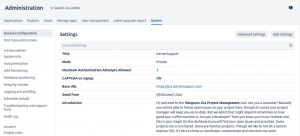Running Jira behind a reverse proxy is common, but SSL termination is where most administrators get stuck. Misconfigurations lead to redirect loops, broken HTTPS, mixed-content warnings, or Jira refusing to load entirely.
The cleanest, most stable setup is to terminate SSL at HAProxy and pass traffic to Jira over HTTP.
If you want a secure, production-ready setup done by experts, explore our Server Security Service or Linux Server Management.
1. Why Use HAProxy for Jira SSL?
HAProxy gives you:
-
Centralized SSL termination
-
Proper handling of HTTP/HTTPS redirects
-
Strong TLS configuration support
-
Zero downtime reloads
-
Ability to route traffic to multiple Jira nodes
-
Better performance under load
-
Cleaner network separation
-
Easier certificate renewal (Let’s Encrypt or commercial SSL)
If you’re planning a clustered Jira setup, pair it with our Proactive Server Management.
2. Install HAProxy (Latest 2.x Version)
On CentOS/AlmaLinux/RHEL:
yum install haproxy -yOn Ubuntu/Debian:
apt install haproxy -yCheck version:
haproxy -vYou should ideally be running HAProxy 2.x, because older versions have weaker TLS defaults.
3. Prepare Your SSL Certificate
Place your certificate and key in:
/etc/haproxy/ssl/jira.pemIf using Let’s Encrypt:
cat fullchain.pem privkey.pem > /etc/haproxy/ssl/jira.pemSet permissions:
chmod 600 /etc/haproxy/ssl/jira.pem4. HAProxy Frontend Configuration (SSL Termination)
Edit:
/etc/haproxy/haproxy.cfgAdd:
frontend jira_https
bind *:443 ssl crt /etc/haproxy/ssl/jira.pem
mode http
option forwardfor
http-request set-header X-Forwarded-Proto https
default_backend jira_backendKey points:
-
SSL terminates at HAProxy
-
X-Forwarded-Proto tells Jira the request is HTTPS
-
forwardfor sets client IP headers
This prevents Jira from thinking the request is HTTP.
5. HAProxy Backend Configuration
Add:
backend jira_backend
mode http
option httpchk GET /status
server jira1 127.0.0.1:8080 checkReplace 127.0.0.1 with your Jira host if needed.
If using multiple nodes:
server jira1 10.0.0.10:8080 check
server jira2 10.0.0.11:8080 check6. Configure Jira to Trust the Proxy
Edit:
/opt/atlassian/jira/conf/server.xmlFind the connector:
<Connector port="8080"
relaxedPathChars="[]|" relaxedQueryChars="[]|{}^\`"
protocol="org.apache.coyote.http11.Http11NioProtocol"
...Modify it as follows:
<Connector port="8080"
protocol="HTTP/1.1"
scheme="https"
proxyName="yourdomain.com"
proxyPort="443"
secure="true"
redirectPort="443"/>Replace:
-
yourdomain.com → actual Jira URL
Without this, Jira will keep redirecting HTTP→HTTPS and break things.
7. Restart Services
Restart HAProxy:
systemctl restart haproxyRestart Jira:
systemctl restart jiraCheck HAProxy config:
haproxy -c -f /etc/haproxy/haproxy.cfg8. Common Problems & Fixes
❌ Jira always redirects back to HTTP
Fix:
You forgot scheme=”https” or proxyPort=”443″.
❌ Browser shows “Mixed Content” warnings
Fix:
Update the Base URL inside Jira admin panel:
Jira Admin → System → General Configuration → Base URL:
https://yourdomain.com❌ SSL works, but Jira refuses to load
Fix:
Ensure:
http-request set-header X-Forwarded-Proto https❌ HAProxy reload fails
Fix permission errors:
chmod 600 /etc/haproxy/ssl/jira.pem❌ Client IP shows 127.0.0.1
Add:
option forwardforin the frontend.
9. Hardening SSL Configuration (Recommended)
Add:
ssl-default-bind-ciphers PROFILE=SYSTEM
ssl-default-bind-options no-sslv3 no-tlsv10Or full hardening:
ssl-default-bind-options no-sslv3 no-tlsv10 no-tlsv11
ssl-default-bind-ciphers ECDHE-ECDSA-AES256-GCM-SHA384:TLS_AES_256_GCM_SHA384:TLS_AES_128_GCM_SHA256Supports:
-
TLS 1.2
-
TLS 1.3
-
Strong ciphers
10. Optional: HTTP → HTTPS Redirection
Add:
frontend jira_http
bind *:80
http-request redirect scheme https code 30111. Final Checklist
-
HAProxy SSL certificate installed
-
SSL terminating on port 443
-
Jira connector updated
-
Base URL set to HTTPS
-
X-Forwarded-Proto header added
-
DNS updated
-
Services restarted
Conclusion
Configuring SSL for Jira behind HAProxy is straightforward when you handle SSL termination, proxy headers, and the Jira connector



Leave A Comment